Kok Chen, W7AY
w7ay (at) arrl (dot) net
December 16, 2012
[This is the second
revision of the article which I first wrote in 2008 (an
earlier revision was mostly a cosmetic update). This
expanded revision includes references and additional
details and diagrams to explain the underlying principles.
A discussion on how this ATC pertains to Leonard Kahn's
"Ratio Squarer" is included in this revision, together with
a comparison of error rates. Section 4 is added to show an
improvement over the traditional ATC by applying only the
clipper from the optimal ATC. The previous version of this
manuscript is available here.]
1. Introduction
Automatic Threshold Correction (ATC) is a technique that is
used in frequency shift keyed (FSK) reception to optimize
the decision threshold level in the presence of selective
fading.
On-Off Keying (OOK) was used in early
wireless transmission of teletype data. With OOK, a
single carrier is keyed on and off to convey binary
information. However, Rayleigh fading on HF propagation
channels causes loss of data when the narrow band OOK
signal fades close to the noise floor.
Frequency Shift Keying (FSK) keys two
separate carriers in a complementary manner. When one
carrier is turned off, the other carrier is turned on.
One of the carriers of FSK is called the Mark carrier,
and the other carrier is called the Space carrier. The
separation of the carriers is called the FSK “shift.”
In an Additive White Gaussian Noise (AWGN)
channel, FSK has a 3 dB sensitivity advantage over OOK
when both of transmitters use the same peak power. The
two toned FSK signal is substantially superior to OOK
since it also provides a form of frequency diversity.
When a multi-path signal produces selective fading, one of the two
carriers can survive sufficiently for the FSK signal to
still be decoded without errors when the other carrier
has faded completely away.
The ATC is a circuit, or an algorithm in the case of a
software modem, that determines how the Mark and Space
tones are combined to take advantage of their behavior
during selective fading. An implementation of DC
restoration (often called an accessor in early papers)
which provides the foundation for early ATC development was
described as early as 1948 in Sprague's '434 patent
[reference 1].
This article introduces two new ATC schemes that improves
upon the "traditional" ATC. Section 4 shows that under
fading, the inclusion of a simple clipper can add about 0.5
dB of sensitivity compared to the traditional ATC, while
the fully optimized ATC that is described in Section 6 can
improve the sensitivity by about 1 dB compared to the
traditional ATC.
2. FSK Demodulation
In the simplest form, shown in Figure 2.1, the information
bits from an FSK signal are demodulated by subtracting the
amplitude of the detected Space component from the
amplitude of the detected Mark component. When the
difference is greater than zero (the threshold level), a
Mark is assumed to be sent. If the difference is less than
zero, a Space is assumed to be sent. This process of
transforming an FSK waveform into a binary level is often
called slicing.

Figure 2.1: Simple FSK
Demodulator
The Mark and Space filters in Figure 2.1 are bandpass
filters that are centered on the Mark and Space frequencies
respectively. For an unbiased slicer, both filters are
designed to have identical noise bandwidth.
The detectors of an FSK demodulator can also operate on
baseband signals, as illustrated in Figure 2.2.

Figure 2.2: Baseband FSK
Demodulator
With the baseband approach, the input signal is mixed by Mark and Space local
oscillators into two baseband signals, which are then
filtered by identical lowpass filters. The baseband
approach is easily adaptable to moving Mark and Space
frequencies, without needing to change data filters.
Different data filters are still needed when the baud
rate changes.
The mixers in Figure 2.2 can also be implemented as
quadrature mixers which produce baseband outputs that are
analytic. After passing through complex data filters, the
detectors can be precisely implemented by taking the moduli
of the filtered components. The quadrature mixed baseband
approach is often used to implement software FSK
demodulators since the detector is close to being ideal.
For optimal demodulation of an FSK bit stream under AWGN, a
Matched Filter is used for the
aforementioned filters.
Matched filters for rectangular pulses are spectrally wide
and susceptible to interference by an adjacent signal. For
this reason, the filters in Figure 2.1 are often
implemented with narrow bandpass filters, or in the case of
the baseband approach in Figure 2.2, by narrow lowpass
filters.
To avoid inter-symbol interference (ISI), the
narrower filters can be designed to satisfy the Nyquist criteria [reference 2, 3]. (An FSK Matched Filter,
by its definition, satisfies the Nyquist criteria.) In
practice, one needs to balance the need to reduce of ISI
with the need to reject adjacent channel interference
and reducing in-band noise.
The narrowest Nyquist filter for a rectangular pulse under
AWGN is the Raised Cosine filter. Although a
Raised Cosine filter generates no internal ISI, its
performance is slightly poorer than a Matched Filter,
which accepts more energy from the FSK signal. See
here for a family of filters with
increasing bandwidths, starting with the bandwidth of
the Raised Cosine and in the limit, ending with the
bandwidth of a Matched Filter, with corresponding better
FSK decoding as the bandwidth is increased.
Another factor that affects the choice of filter bandwidth
is that the HF channel can widen the transmitted pulse
width, causing large errors from a Raised Cosine that is
designed for a perfect pulse.
For an ideal FSK signal with baud rate B, the 6 dB cutoff
for a Raised Cosine filter is B/2 Hz, with zero response
past B Hz. The impulse response of a Raised Cosine filter
therefore rings indefinitely. When a Raised Cosine filter
is approximated with an FIR structure, the Raised Cosine
impulse response is truncated to have a finite support and thus, like all FIR
filters, cannot be truly bounded in the frequency
domain.
3. Automatic Threshold Correction
(ATC)
Selective fading causes the Mark and Space amplitudes to
become unequal. When that occurs, the simple FSK
demodulators with the unbiased thresholds are no longer
optimal. Frerking [reference 4] has a detailed analysis of
an Automatic Threshold Correction (ATC) circuit when the
Mark component of an FSK signal suffers a deep fade.
The standard ATC circuit, shown in Figure 3.1, is created
by adding a pair of envelope detectors (shown in the figure
below as boxes labelled ENV) to bias the levels of the
detected Mark and Space signals. The envelope detector
tracks the amplitude of a carrier as it goes through a
fade. In the simplest implementation (the one described in
Frerking), the envelope detector can be a simple
Fast-Charge-Slow-Discharge circuit (most often seen in AGC
circuits). The time constants are chosen to be slow enough
so that the ENV output does not track individual data bits.
With a software demodulator, it is very easy to delay the
actual signal path relative to the ENV path so the ENV
stage can look ahead at the “future” trend of the envelope.
With a lag of just a dozen bits, much better estimates of
the Mark and Space envelopes can be obtained compared to
the use of Fast-Charge-Slow-Discharge circuits.
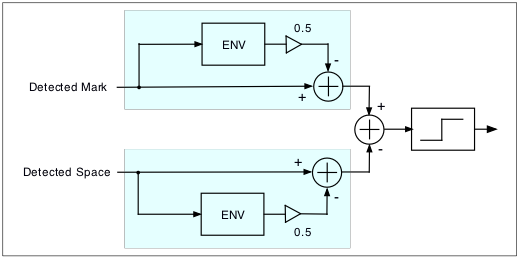
Figure 3.1: Automatic
Threshold Correction (ATC)
As seen in the above figure, one half of the envelope is
subtracted from the input signal. When the two FSK carriers
no longer have equal amplitudes, the two envelopes become
unequal and that in turn biases the slicer threshold
towards the midpoint of the Mark and Space envelopes.
Since the incoming detected Mark and detected Space signals
also includes detected noise (not zero mean), the ATC as
described above is still not completely unbiased when the
noise term is non-zero.
4. Compensating for the Noise Floor
With a little extra complexity added to the linear ATC that
was shown in Figure 3.1, we can account for a non-zero
noise floor.
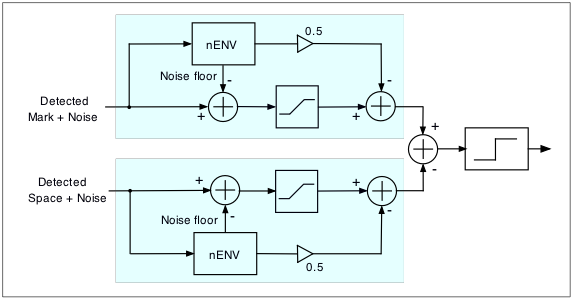
Figure 4.1: ATC with Noise
Floor Correction
In Figure 4.1 above, in addition to the envelope, the noise
floor is also computed in the nENV stages shown. The noise
floor is subtracted from the signal itself.
After removing the noise floor, the signal is sent to a
clipper that prevents the translated signal from falling
below zero in case the instantaneous signal falls below the
average noise floor. The clipper also keeps the output from
exceeding the value of the envelope (ceiling), viz.

Since the composite envelope also includes a noise
contribution, the same noise floor has to also be
subtracted in a similar manner from the composite envelope
to maintain an unbiased threshold.
![]()
Because the same amounts are subtracted from both Mark
and Space channels, the noise floor adjustment has no
effect when it is not used in conjunction with a
clipper. The combination of noise subtraction and
clipping is surprisingly effective; this clipped
ATC can, for example, improve demodulation sensitivity
of the traditional ATC by 0.5 dB, and reducing error rates
by about a factor of two, when one carrier is 10 dB weaker
than the other (see charts in Section 7 below).
If the Mark and Space filters have identical noise
bandwidth, a slight improvement can be realized by
averaging the noise power that are measured by the two nENV
stages and using the mean as the common noise power for
both Mark and Space correction.
5. An ATC Problem
The ATC automatically turns the demodulator into a
Mark-only demodulator when the Space signal fades
completely away, and it automatically turns the demodulator
into a Space-only demodulator when the Mark signal fades
completely away.
In between these two extremes, and different selective
fading ratios, the ATC that is shown in Figure 3.1
establishes an unbiased threshold for the slicer to
compensate for the difference in the amplitudes of the Mark
and the Space signals.
A closer inspection shows however that there is a problem
with the ATC circuit shown. While the decision
threshold may be optimal, the signal to noise ratio (SNR)
is not. I had serendipitously stumbled upon this while
investigating better methods for estimating the Mark and
Space envelopes.
Notice that even when multipath causes the Space signal to
completely fade away, the noise (combination of sky noise
and receiver noise) from the Space filter survives, and the
ATC circuit can be reduced to Figure 5.1 below.
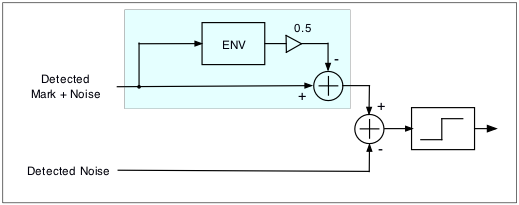
Figure 5.1: ATC Under
Mark-only Condition
The decision threshold for the slicer remains correct,
assuming that the Mark and Space filters both have the same
noise bandwidths. Since noise is uncorrelated with the Mark
signal, the "Detected Mark + Noise" term can be written as
"Detected Mark + Detected Noise."
Compare the above figure to a true Mark-only demodulator,
shown in Figure 5.2.

Figure 5.2: Mark-only
Demodulation
Since the noise contribution from the Space channel remains
in the ATC circuit (Figure 5.1), the slicer sees about 3 dB
more noise than the slicer in the Mark-only circuit (Figure
5.2).
Because of this, the traditional FSK demodulator (with or
without an ATC) will have a degraded signal to noise ratio
even when one of the channels has only partially faded
away, reaching a 3 dB deficit in SNR when one of the
carriers has faded completely away.
6. SNR-optimized FSK Demodulator for
Selectively Fading Channels
We can attempt to remove the noise
contribution from a channel that is under selective fading
by applying a controlled gain term before the faded signal
reaches the slicer. Figure 6.1 illustrates a gain
controlled stage in the Space path case where an ATC is not
used. The magenta region models the Space signal with a
fade factor of k.
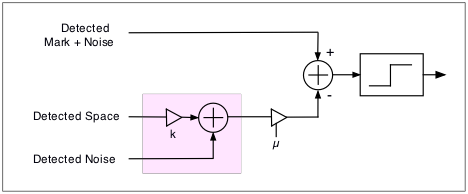
Figure 6.1: Fading
Model
Given uncorrelated noise in the Mark and Space channels,
and a selectively faded Space signal that is attenuated by
a factor k
relative to the Mark signal, the SNR at the slicer is
proportional to
![]()
where µ is a
gain that is applied to the Space path. The numerator is
proportional to the total signal power as seen by the
slicer, while the denominator is proportional to the total
noise power.
By setting the derivative of Equation 6.1 with respect to
µ to zero, it
can be seen that the maximum SNR is achieved by making
µ =
k, viz.
to optimize SNR, µ should be linearly
proportional to the fading factor k.
Recall that the ENV (envelope detector) stage
measures a scalar that is proportional to k , Figure 6.2 shows the
ATC-less FSK demodulator that optimizes the SNR for the
slicer when there is selective fading from either Mark or
Space signals (by superposition, the same Equation 1
applies to the Mark channel).
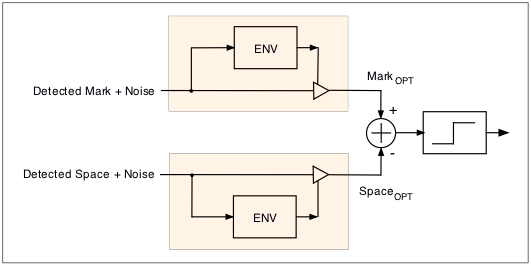
Figure 6.2: ATC-less
Demodulator that is Optimized for Selective
Fading
The ATC bias for MarkOPT and SpaceOPT
in Figure 6.2 can be derived per Frerking, e.g., the bias
for MarkOPT is one half of
ENV(MarkOPT). It can also be seen by inspection
that ENV( x.ENV(x)) is just ENV2(x).
By including the ATC component to Figure 6.2, we get the
FSK ATC that is optimized for a selective fading that is
shown in Figure 6.3.
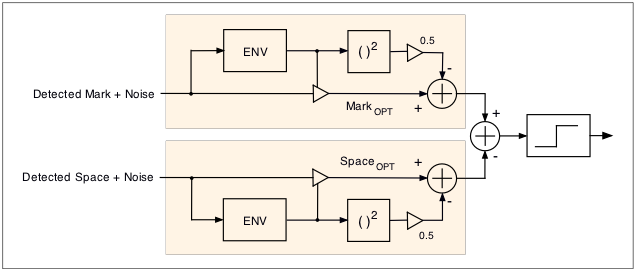
Figure 6.3: FSK
Demodulator that is Optimized for Selective
Fading
Notice that the mark and space filter outputs in the above
figure are multiplied by a gain factor before they are
sliced. As we had mentioned earlier, the optimal gain is
achieved by multiplying the mark and space signals by the
amplitude of their own envelopes. Thus the gain control
terms are simply the output from the envelope detectors.
When the envelope of a channel drops by a factor of
k, for
optimal SNR, we attenuate it further by yet another factor
of k. Thus, a
channel that has selectively faded by a factor of
k will move
the optimal slicer threshold (the rightmost parts of the
shaded areas in the above figure) by a factor of one half
of the square of k.
With this algorithm, when the Space signal fades all the
way down to the noise floor due to selective fading, the
output of the space filter (which includes the noise in the
Space channel) is reduced to zero before is subtracted from
the Mark signal. As a result, the noise from the space
filter is also attenuated to zero. I.e., during extremely
deep selective fading, this new demodulator behaves
precisely like a Mark-only demodulator that was shown in
Figure 5.2.
Finally, by incorporating the noise floor compensation and
clipper that was shown earlier in Figure 4.1, Figure 6.4
shows the FSK ATC that is optimized for selective fading
and noise floor.
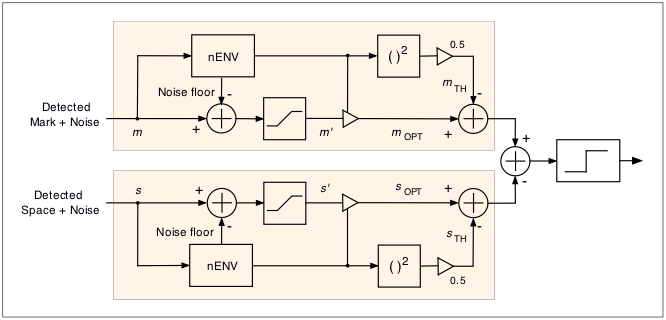
Figure 6.4: FSK
Demodulator that is Optimized for Selective Fading (Noise
Compensated)
Following Figure 6.4,
if we let m and s be the detected Mark
and Space signals (including noise), and n be the
common noise floor, then
![]()
and
![]()
The slow control signals that are generated by the nENV
stages are defined as
![]()
and
![]()
where env(m) and env(s) are the envelopes
of the detected Mark and Space signals (that includes
noise).
The SNR optimized Mark and Space signals are thus:
![]()
and
![]()
while the threshold bias values are
![]()
and
![]()
The demodulator then determines that a Mark is received if
![]()
otherwise, the demodulator determines that a Space is
received.
7. Performance
The following is a plot of Character Error Rate (CER in
percentage of character errors) versus signal-to-noise
ratio (SNR) for a 45.45 baud start-stop FSK signal in an
AWGN channel where the Mark and Space carriers are
imbalanced by 10 dB (to simulate sustained selective fading
where one of the carriers has faded by 10 dB).
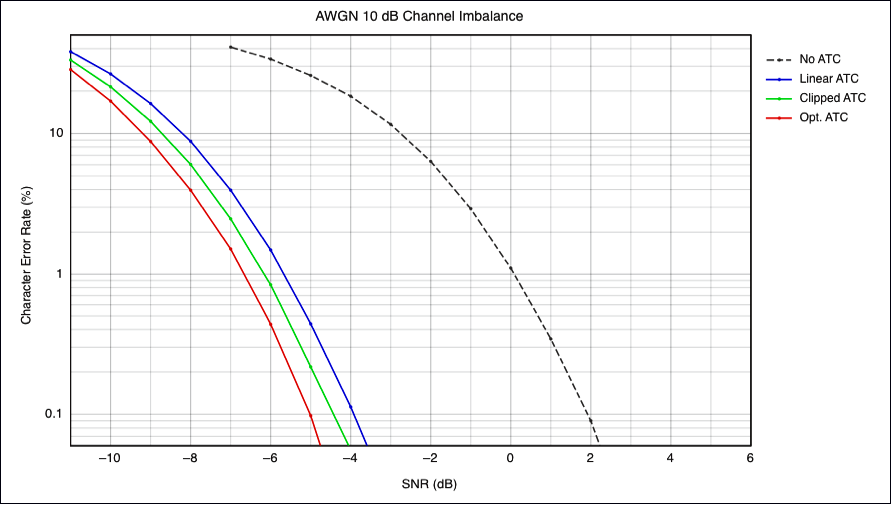
Figure 7.1: ATC
Performance with 10 dB Channel Imbalance
The SNR (horizontal axis) is referenced to a noise
bandwidth of 3 kHz. For the SNR in a 300 Hz noise
bandwidth, add 10 dB to the horizontal scale.
The black dashed curve is the error rate in the absence of
an ATC circuit. The blue curve is for a traditional
"linear" ATC, as described in Section 3. The green curve is for the
ATC with a clipper that is described Section 4. The red curve is for the
SNR optimized ATC that is shown in Figure 6.4 of Section 6.
(Please note that the previous version of this article had
used synchronous bit clocking. The error rate for chart
above is computed using asynchronous 5 bit characters, with
1 start bit and 1 stop bit).
8. Conclusion
It can be seen from Figure 7.1 that for a 2% character
error rate and given a 10 dB Mark/Space imbalance, a simple
"linear" ATC improves sensitivity of a demodulator that has
no ATC by about 5.7 dB. An extra 0.5 dB is gained by
introducing a clipper into the ATC correction signal.
The SNR-optimized ATC gains yet another 0.5 dB to produce a
total of approximately 1 dB improvement over the linear
ATC.
It can also be seen that under the above conditions, the
optimized ATC produces 3 times fewer error than the linear
ATC when the SNR is -6 dB.
Appendix A: Kahn's Ratio Squarer
Leonard Kahn applied for a U.S. patent in 1953 for a method
to combine the outputs from diversity receivers. The patent
was granted U.S. Patent 3,030,503 in 1962. Kahn also
submitted a correspondence ("Ratio Squarer") to the
Proceedings of the IRE in 1954 that described the same
method [Reference 5].
Until Kahn's work, the primary method for diversity
reception was to pick the stronger signal from two
diversity receivers. Kahn instead suggested summing the
output from the receivers after applying a correction to
optimize the SNR of the resulting sum.
Kahn had started with (the following equations are taken
from Kahn's papers):

as the SNR of the sum of the outputs from the two
individual receivers, where X is the ratio that is applied
to the output of receiver 2 before it is added to the
output of receiver 1. S1/N1 and
S2/N2 are the SNR at the two
receivers. When N1 = N2 (i.e., the
two receivers have the same noise bandwidth), Kahn
determined that for optimal SNR,
![]()
which leads to Kahn's "Ratio Squarer" equation,

I.e., the optimal way to directly combine the signals is to
take the square (power) from each receiver. Please note
that implicit in this result is the need for the noise
bandwidths of the two receivers to be identical.
When selective fading causes only one of the FSK carriers
to fade, the Mark and Space carriers can be considered to
be components of a frequency diversity system. For this
reason, the Kahn "Ratio Squarer" has been used in FSK
demodulation to square the detected Mark and detected Space
signals before submitting the Mark and Space powers to a
slicer.
Note that squaring the Mark and Space signals is different
from the approach that was describe earlier in Section 6. The method that was
described in Section 6 applies a slowly varying gain
adjustment to a scalar value (e.g., the detected Mark
signal). After being gain controlled, the values that
are sent to the slicer remain as scalars. By following
Kahn, the squaring of the detected Mark and Space
signals results in the slicer working on powers instead
of on scalars.
Figure A.1 below shows the result when the squared signals
are passed through an ATC that works on power values (green
curve). Interestingly, the use of a clipper from
Section 4 also improves the performance of the squaring
demodulator (red curve).
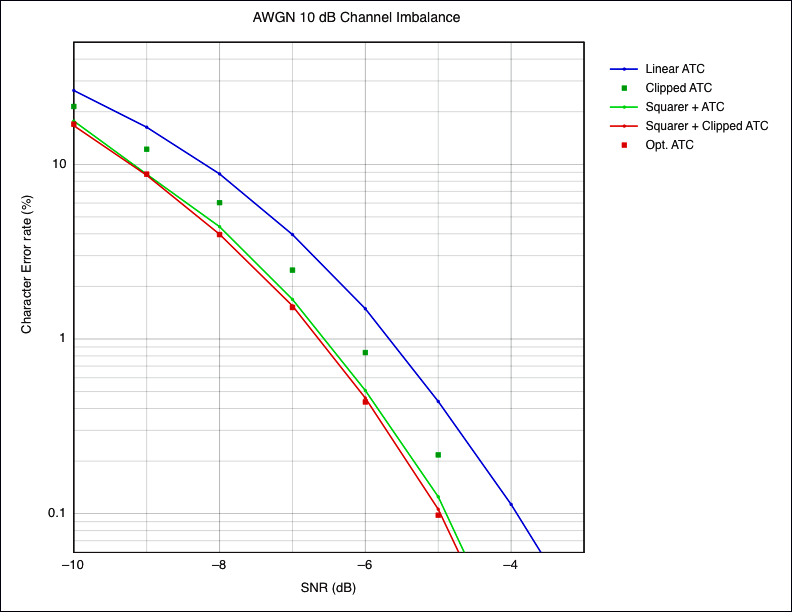
Figure A.1: Squarer + ATC
Performance with 10 dB Channel Imbalance
For comparison, the blue curve is the "linear ATC" that is
described by Frerking. The green squares in Figure A.1
correspond to the simple Clipped ATC method that was
described earlier in Section 4. The red squares correspond
to the Optimal ATC that was described in Section 6 above.
It should not be too surprising that the Kahn squarer and
the Optimal ATC described earlier give very similar
performance since both are based upon optimizing the SNR,
as long as a clipper is also applied before the squared
outputs are sent to the slicer (the "Optimal ATC"
implicitly contains a clipper).
In Figure A.1, the "Optimal ATC" (red squares) shows a very
slight performance improvement over squaring when the SNR
is -7 dB or better, while the squarer with the clipper (red
curve) has a similar slight performance edge when the SNR
is worse than -7 dB. This could however, simply be caused
by the small errors that were made when estimating the
noisy envelopes for the threshold correction.
Appendix B: Pseudo Code
The following are pseudo code segments that describe each
of the methods described above.
Assuming
m = detected mark amplitude
s = detected space amplitude
me = detected ( mark + noise ) envelope
se = detected ( space + noise ) envelope
mf = Mark channel noise floor
sf = Space channel noise floor
nf = ( mf + sf )*0.5
Each ATC method is defined by:
// No ATC (Section 2)
v = m - s
// Linear ATC (Section 3)
v = m - s - 0.5*( me - se )
// Clipped ATC (Section 4)
if ( m < nf ) m = nf
if ( m > me ) m = me
if ( s < nf ) s = nf
if ( s > se ) s = se
v = ( m-nf ) - ( s-nf ) - 0.5*( ( me-nf ) - ( se-nf ) )
// Optimal ATC (Section 6)
if ( m < nf ) m = nf
if ( m > me ) m = me
if ( s < nf ) s = nf
if ( s > se ) s = se
v = ( m-nf )*( me-nf ) - ( s-nf )*( se-nf ) - 0.5*( ( me-nf )**2 - (se-nf)**2 )
// Kahn Squarer with Linear ATC (Section 8)
v = ( m-nf )**2 - ( s-sf )**2 - 0.25*( ( me-nf )**2 - (se-nf)**2 )
// Kahn Squarer with Clipped ATC (Section 8)
if ( m < nf ) m = nf
if ( m > me ) m = me
if ( s < nf ) s = nf
if ( s > se ) s = se
v = ( m-nf )**2 - ( s-sf )**2 - 0.25*( ( me-nf )**2 - (se-nf)**2 )
The slicer produces the final decoded output:
if ( v > 0 ) decoded output = 1 else decoded output = 0
References
- Robert M. Sprague i, Automatic Signal
Bias Control Means and Apparatus, U.S. Patent
2,443,434 (1948) issued to Press Wireless, Inc.
- Harry Nyquist ii, Certain Topics in
Telegraph Transmission Theory, AIEE Transactions,
Vol 47, April 1928, pp 617-644.
- Richard A. Gibby iii, Smith, J.W.,
Some Extensions of Nyquist's Telegraph Transmission
Theory, Bell Systems Technical Journal, Vol 44,
September 1965, pp 1487-1510.
- Marvin E. Frerking, Digital Signal Processing in
Communication Systems, Chapman & Hall, New York,
1994. ISBN 0-442-01616-6.
- Leonard R. Kahn iv, Ratio
Squarer, Correspondence, Proceedings of the IRE,
November 1954, page 1704.
Notes:
- A complete pdf file containing the page images of
Sprague's U.S. Patent 2,443,434 can be obtained from
http://www.pat2pdf.org.
- A reformatted version of Harry Nyquist's 1928 AIEE
paper can be found here: http://astro.if.ufrgs.br/med/imagens/nyquist.pdf.
The original can be downloaded for free from the IEEE
web site if you are an IEEE member, or for a small fee
if you are not a member.
- The Gibby and Smith paper is available at the BSTJ
web site here: http://www.alcatel-lucent.com/bstj/vol44-1965/articles/bstj44-7-1487.pdf.
- Kahn's IRE Correspondence is available at http://ieeexplore.ieee.org/stamp/stamp.jsp?tp=&arnumber=4051586.
A similar presentation appears in Kahn's US Patent
3,030,503, granted on April 17, 1962, and available at
the uspto.gov web site, or as a complete pdf file from
http://www.pat2pdf.org.